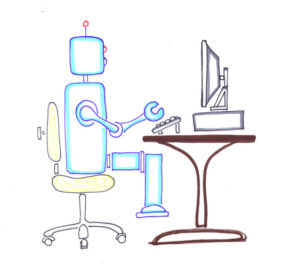The staff editorial is the majority opinion of The Murray State News Editorial Board

It’s official: robo-journalists are ready to attack us all, destroy the world and defame the Constitution.
Just kidding – they’re probably not going to do that. Robo-journalists are real, though.
During the 2016 Rio Olympics, the Washington Post tested out a robotic results-gathering machine in order to quickly churn out rankings for their stories. This machine – let’s just call it what it is, a robot – was called Heliograf. The robot did well, apparently, because now the Post is using the robot for election coverage, too.
Heliograf has graduated from its simple form as a number-cruncher and is now an assistant to human journalists. Through programming, the bot can now produce sentences along with statistics and similar material in order to tweet, post to blogs and write stories. The bot’s creations are supposed to be checked by a human journalist before publishing, according to The Washington Post. But how can we trust them as a source now? They’re using robots to do their reporting.
Will Smith-style “I, Robot” fears aside, this is a troubling situation and one that could threaten real (read: human) journalists around the globe.
Right now, these bots are still referred to as “assistants,” meaning the majority of writing and editing power is in the hands of real journalists. But if the bot possesses the power to write tweets and other posts, how long will it be before it creates full-length stories and publishes them? One more story for a robot is one less story for a real journalist – one who sacrifices time, energy and resources in order to do the job they’ve spent years training for.
It’s not likely that a rise in robo-journalists would result in major job reductions, but it would erase the humanity from more stories. A criticism of the robo-journalists is that the prose they produce is too straight-forward and flat. While journalism should be unbiased and clear – a perk of using the bot, if there has to be one – it shouldn’t be completely void of emotion. Even if the bots were programmed to write with some sort of algorithm-produced emotion, would they ever reach the ability to write feature stories, conduct interviews or have revelations about what a source provides? Maybe, and that’s the frightening part.
On the other side of the coin, these mechanical journalists could be useful, especially for election purposes. The bots can collect and organize information far more quickly than humans can, and in our technological society set for instant gratification, using resources like Heliograf could allow news outlets to churn out more accurate content within seconds.
The Washington Post’s director of strategic initiatives said the robot “allows The Post to create stories that are better than any automated system but more constantly updated than any human-written story could be,” according to their latest story on the issue.
Furthermore, not all stories have that much humanity in them – many sports stories often use numbers, charts and similar reports as driving elements. For these kinds of posts, the robo-journalist is ideal.
The bots, unlike humans, also don’t have to deal with travel and the associated costs. These machines can retrieve, create and send information from remote locations – their use could potentially save news outlets a significant amount of money in travel and worries concerning insurance and safety.
The robo-journalists do have advantages, but don’t expect to see us favoring any Heliografs over our team of dedicated student journalists any time soon.
Call us old fashioned, but maybe journalistic writing – and protecting the freedom of press and free speech, while we’re on the topic – should be left to real people, some AP Stylebooks and a lot of elbow grease.